The burst fade and drop fade are standout hairstyles created with precise fading techniques that highlight unique style preferences and detailed blending. Both fades carry distinct nuances and effects that can transform your look and help you decide the best option that truly fits your goals. Explore their differences and learn how to choose the right fade for your hair to achieve a top-tier finish
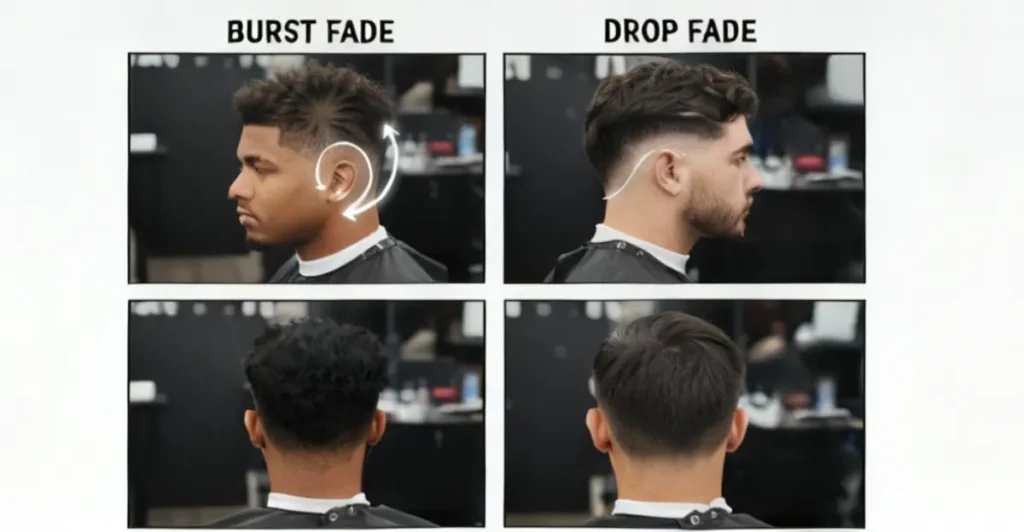
Table of Contents
What is burst fading?
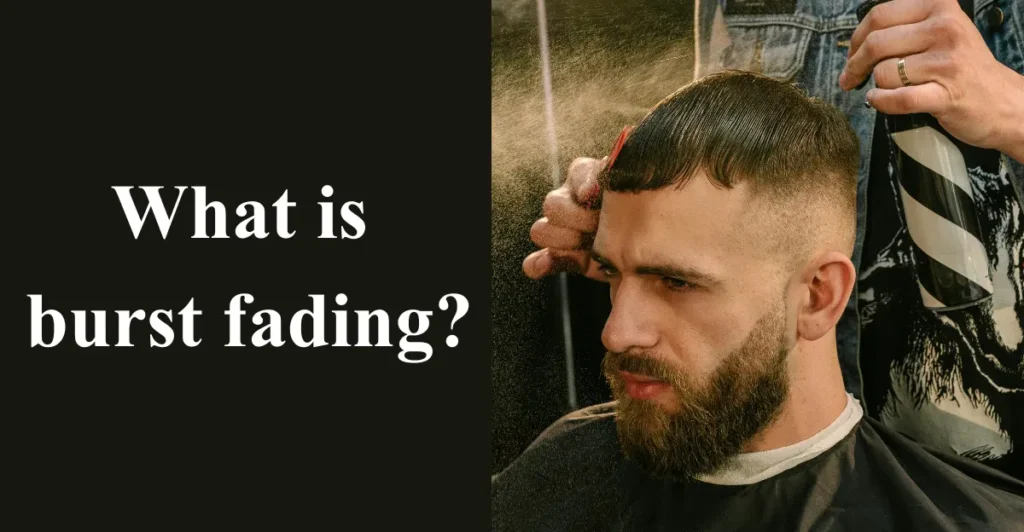
Burst fading is a technique in modern hairstyling where the fade spreads around the ear like rays of the sun and when it is paired with balayage or hair coloring, it brings more depth and movement. Instead of relying on traditional highlighting with foils, the stylist uses a freehand application that feels like pure art with hand-painted strips of lightener added to strands for a soft and diffused finish. The highlights follow an irregular pattern, which gives darker hair extra dimension and creates a sun-kissed and natural-looking effect.
The pieces are painted and lightened in a way that blends seamlessly with the base color, so there is no demarcation and the regrowth is disguised as the hair grows out without a harsh line. This connection between fading and coloring makes the style low maintenance since it does not need to be touched up frequently.
Personally, I’ve seen how skillfully applied fades with clever color placement not only ensure a polished look but also elevate confidence, proving the world of fades and coloring is truly about balance and detail when done right.
What is drop fading?
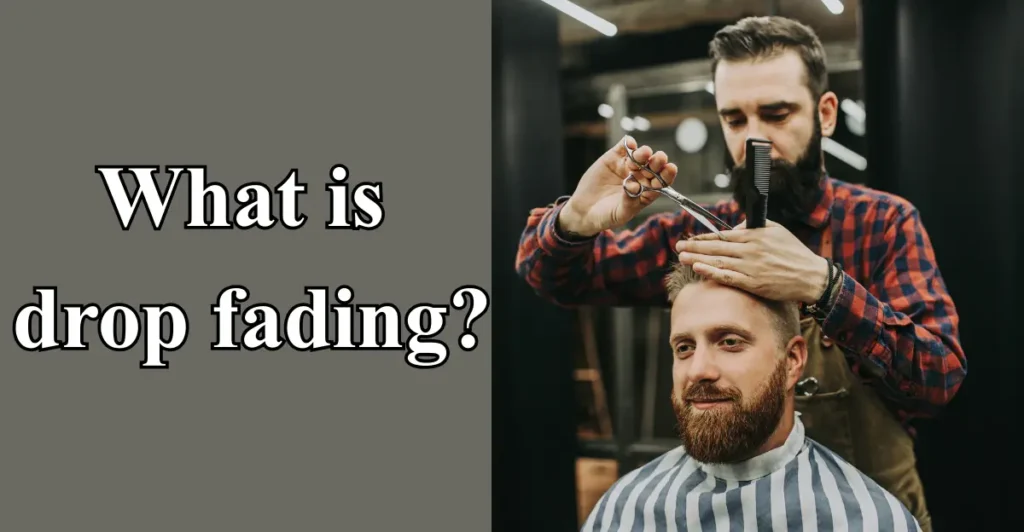
Drop fading is a popular option in modern haircuts where the fade curves down around the ears and the neckline to create natural and blended transitions that differ from burst fading. In hairstyling, this type of cut usually follows the shape of the head as the length on top stays longer while the sides and back are shorter, producing a smooth transition that can resemble an ombre effect. Some barbers even combine it with dip dyeing or color work so the dark roots and light tips give a polished flow without a harsh or visible line near the temples.
When color is involved, stylists may use techniques like highlight foiling to isolate pieces where foils keep the lightener controlled until it is applied and later removed once the desired level of lightness is achieved. Depending on the processing time, the results can be a high-contrast look or something subtle. As the hair grows, a demarcation line becomes more apparent, which means this style often needs regular touch-ups to maintain its flow.
From my experience as a barber, I have noticed that clients enjoy the drama a drop fade creates but they should know it is a higher maintenance choice compared to softer fades, and I always guide them toward what suits their lifestyle best.
Key differences
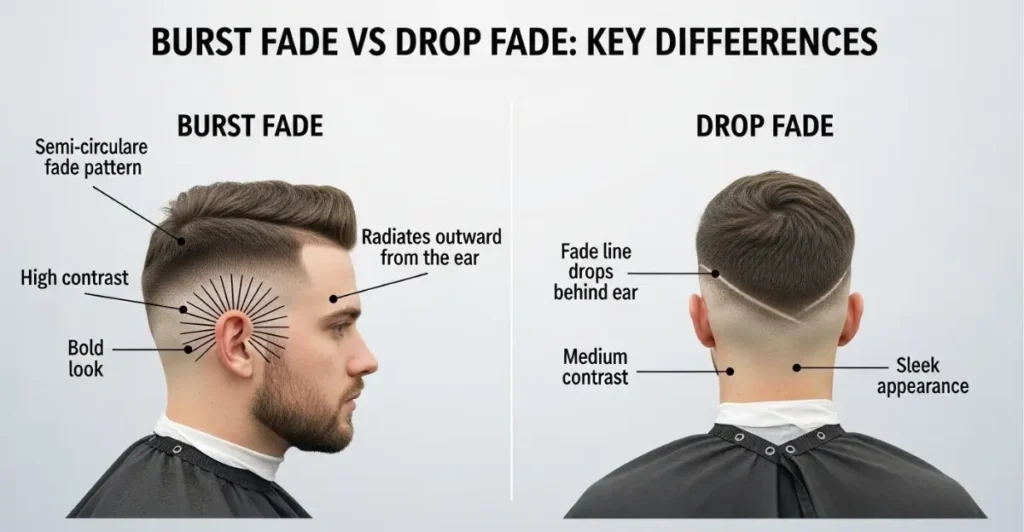
The main differences between burst fading and drop fading lie in how the fades are created, how the color is applied, how they grow out, and what kind of upkeep each style demands.
Application Method
Burst fading often uses freehand painting where highlights are placed in an organic way to mimic natural light movement, while drop fading relies on foils to isolate pieces for a more defined and deliberate lightening application method.
Roots
With burst fading, the roots are softened as the highlights blend into a natural transition, whereas drop fading usually leaves the roots dark and builds lightness through the mid-lengths and ends.
Regrowth
Burst fading keeps regrowth subtle since it cleverly disguises growth, but drop fading makes demarcation visible as treated and new hair show a more pronounced line depending on the approach used.
Contrast
The contrast in drop fading is stronger, with a sharper distinction between roots and ends, while burst fading creates a softer look where the change is less stark and not as clear.
Maintenance
In terms of maintenance, burst fading requires less upkeep as the subtle regrowth grows out smoothly, while drop fading needs regular salon visits to keep the contrast fresh, making it an essential consideration for clients.
Versatility
Versatility plays a role since burst fading works with any hair length and is almost universally flattering, while drop fading is a better option for medium to long hair.
Cost
The cost of drop fading is often priced lower because foiling is usually quicker, while burst fading with hand-painting and highlights can raise salon pricing as it may vary based on the intricacy, time, and technique required.
From my personal experience, clients who want a softer and more natural look tend to lean toward burst fades, while those who enjoy bold structure and do not mind a bit more maintenance usually choose drop fades.
Which should you choose?
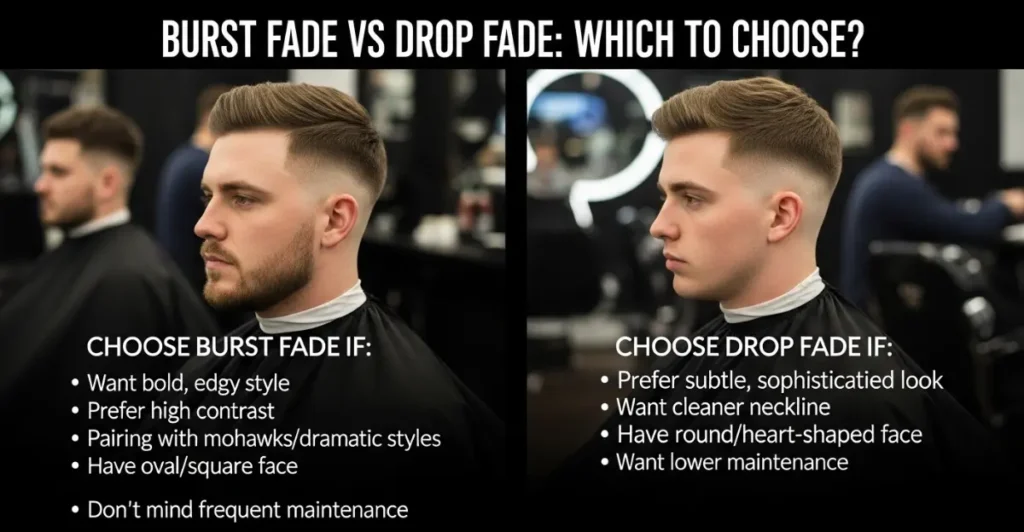
If you want a low-maintenance look with a soft contrast, then burst fading is the best choice since it grows out beautifully without the need for frequent touch-ups. It offers a style that is more versatile and works with almost any hair length, making it likely to suit a wide range of preferences.
On the other hand, if you prefer a high-fashion and bold finish with an ombre flow that makes a clear statement, the drop technique may be the better fit. It shines most on shoulder-length or longer hair, though it requires regular appointments to keep regrowth touched up and the pace of upkeep can be higher.
From my personal experience, clients who want easy upkeep almost always prefer burst fades, while those who love making a statement lean toward the drop technique for its bold impact. I find that guiding them based on lifestyle helps them feel confident in their look long after they leave the chair.
Conclusion
Choosing between a burst fade and a drop fade comes down to your style, maintenance preference, and the look you want to achieve. Both fades offer precision, versatility, and the chance to showcase your individual style. With the right technique and products, your hair can reflect a modern, polished, and confident appearance. Book a visit today and let expert barbers craft a cut above that perfectly fits your personality.
FAQs
How often should I get a burst fade or drop fade touched up?
Burst fades are low-maintenance and can grow out beautifully with minimal touch-ups, while drop fades require more frequent salon visits to maintain sharp contrast and clean lines.
Which fade is better for longer hair?
Drop fades work best for shoulder-length or longer hair, creating a bold statement, while burst fades are versatile and flattering for almost any hair length.
